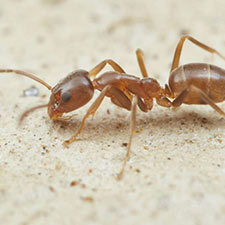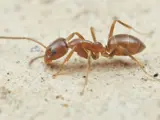 Argentine ant
Argentine ant
Common name: Argentine ant
Botanical name: Linepithema humile
Management programme: Advisory
Where are they originally from?
Originally from South America (Argentina, southern Brazil, Paraguay and Uruguay). It was first discovered in New Zealand in 1990 from a population linked to Australia, likely through contaminated cargo.
Why are they a pest?
- A domestic nuisance, invading houses and getting into cupboards, sealed jars, electrical areas, behind walls and beds.
- Aggressive swarming behaviour in gardens and sometimes biting.
- Expensive and difficult to treat.
- Impacts some productive horticultural sectors.
Where are they found?
Argentine ants favour sandy coastal and volcanic soils but have also been found in other areas associated with human activity that have aided their spread.
What do they look like?
- A 2-3mm long ant with a uniform honey-brown colour.
- Foraging ants move steadily (not slowly) in defined continuous trails that are often seen going up trees or shrubs.
- Capable of biting.
- They give a light greasy odour when crushed compared to the strong formic acid smell of some other ant species.
What are the rules?
Advisory
Council does not enforce the control of advisory species. It is landowner/occupier responsibility to manage these pests. Council may provide advice on how to manage or control advisory species if required.
How do you get rid of them?
- Baiting, insecticide – a number of bait options are currently on the market, although baiting needs to be strategic and well-coordinated or results will be limited.
- Professional pest controllers are recommended.
CAUTION: When using insecticide please READ THE LABEL thoroughly to ensure that all instructions and safety requirements are followed.
DISCLAIMER: Information in this fact sheet regarding insecticides does not necessarily appear on the labels of the products concerned. Bay of Plenty Regional Council does not accept liability for any damage that may arise from the use of insecticides at non-standard rates. Mention of product trade names implies neither endorsement of those products nor criticism of similar products not mentioned. Bay of Plenty Regional Council does not accept liability for any damage or injury that may arise from the use of traps, toxins and firearms.
Read more on pest control guidelines and regulations
Images

